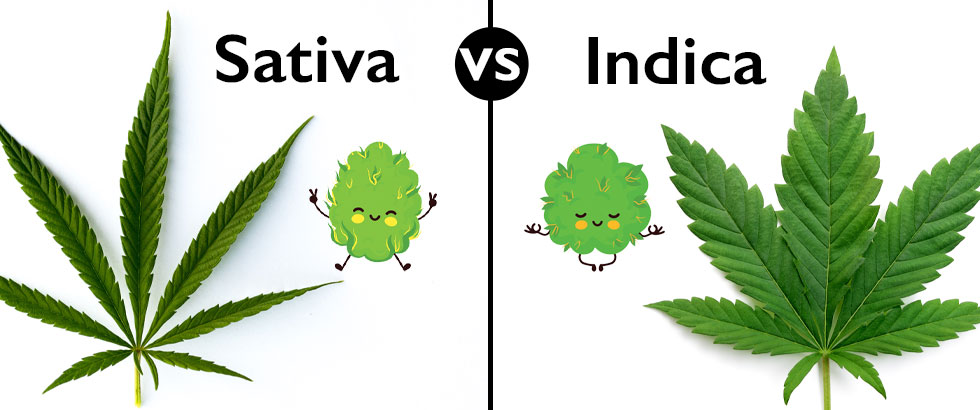Sativa strains are normally supposed to be more energetic and creative than their drowsy Indica counterparts, while Indica strains are typically thought to have soothing and sedative characteristics. We now know that it’s not quite so clear-cut, though, as we discover new information about the cannabis plant every day and develop new strains.
If you examine the chemical “ingredients” that go into creating Indicas and Sativas more closely, you’ll see that there aren’t any obvious patterns that would explain why one strain would naturally be calming while the other is energizing. Discover the specific properties and medicinal effects of both plants in the article.
Table of Contents
ToggleAn Informative Overview of the Main Cannabis Subspecies: Indica vs. Sativa
The two most common strains of marijuana plants are Indica and Sativa. Sativa tends to be invigorating, whereas India tends to be soothing. Additionally, hybrids are produced by breeding Indica and Sativa plants. However, each strain is distinct and has a different effect on every person.
What is Indica?
Afghanistan, Pakistan, and Tibet are among the nations in the Middle East where the Cannabis Indica plant was first domesticated. It is often believed that Indica has a flat, calming high and is a great pain reliever. A hybrid variation of this strain can be found in many medical marijuana strains.
Due to their widespread popularity, Indica strains are typically the most prevalent type of cannabis available. Due to their potent sedative properties and dense buds, Indica strains are frequently thought of when consumers picture the effects of cannabis.
Customers who want to consume marijuana for personal use and are looking for a calming variety will frequently choose an Indica. It’s also beneficial for those who are only concerned with cannabis’ potential medical benefits, such as the alleviation of chronic pain, stress, mood disorders, and other physical and mental health difficulties.
· Benefits of Indica
Indica strains are renowned for their calming and tranquil effects. They can be useful in the management of pain, anxiety, and sleeplessness. Additionally, Indica strains are thought to increase hunger and relieve muscle cramps.
Indica offers the physical high that makes it harder to get up from the sofa and increases dopamine, creating a true sense of happiness.
Indica, however, is also fantastic for your body in addition to its benefits for your mind. Everything from pain treatment to inflammation reduction and even nausea alleviation can be helped by Indica.
What is Sativa?
Sativas, which are sometimes regarded as stimulating, was originally grown in warm, humid settings. They grew long and lanky so they could dry out and not absorb as much moisture. Due to the lack of rain and cold weather at the end of the growing season, they might also take a very long time to grow, flower, or create buds due to their warm climate.
Although it can make some individuals feel anxious, the consensus is that it gives off a more energized and creative high. People who have sadness, migraines, nausea, or appetite loss may find relief from these conditions with Sativa.
Some strains may even have an upbeat effect as opposed to a depressant, giving users a positive boost that is particularly useful for intellectual and creative activities. Additionally, Sativa is claimed to be beneficial for ADHD, social anxiety, and even depression.
· Sativa Advantages
Sativa strains are renowned for their stimulating and uplifting qualities. They can be beneficial in the treatment of stress, exhaustion, and depression. The attention and inventiveness of Sativa strains are also thought to be enhanced.
Sativa is a not-so-secret tool for breaking through that invisible barrier because it stimulates creativity and even improves focus. Serotonin, which affects appetite, learning, mood, sleep, and anxiety, is increased in Sativa.
Sativa and Indica Differences
Cannabis Indica and Cannabis Sativa have several significant distinctions from one another. Effects, smoke, odor, flowering period, bud density and size, leaf structure and size, internodal length, stature, and height, are a few of them. Sativa plants grow taller and bushier than Indica plants, which tend to be shorter.
Sativa and Indica plants have different physiological effects, but they also have different physical characteristics. Short and stocky, with large, “chunky,” leaves, Indica plants have short stems. Sativa plants have thin, pointed leaves and are often taller, skinnier, and sometimes somewhat lanky in appearance.
· Odor
The age of the flower (bud) and how it is stored has a greater impact on the strength of the aroma of cannabis than the strain itself.
The strongest scents are typically found in younger buds that have been stored in sealed containers. However, the fragrance characteristics of Sativa and Indica are distinct. Indica flowers tend to have a muskier, skunkier aroma overall, whilst Sativa flowers tend to have a little more sweetness and brighter overtones.
· Physical Characteristics
The physical distinctions between Indica and Sativa plants are so pronounced that growers can discern the difference between the two merely by taking a glance at them.
Plants grown in Indica are shorter. They often reach a height of 2 to 4 feet, and their compact branching pattern gives them the illusion of being bushy. The leaves of Indica are likewise wider. Indica strains often have short, wide leaves with wide blades, whereas Sativa strains typically have long, thin leaves with long blades.
Sativa strains are more prone to produce long, sausage-shaped blooms, whereas Indica strains are more likely to produce wide, dense, and bulky buds. The height of Sativa plants can range from 5 to 18 feet or more, making them taller than Indica plants. The plants of Sativa varieties have fewer branches and thin leaves.
· Effects on the Body
Compared to Sativa plants, Indica plants are smaller and bushier. Additionally, they are deeper in color and have broader leaves. With higher THC concentrations, Indica strains typically have more strength. They are also renowned for creating a “body high” and for being more calming.
Compared to Indica plants, Sativa plants are both higher and thinner. Moreover, they are lighter in color and have smaller leaves. Sativas typically have lower THC concentrations and are less powerful. They are supposed to give you a “head high” and be more invigorating.
· Drug Efficacy
However, the medical properties of these two-cannabis subspecies, as well as how they affect productivity and energy levels, represent the most significant distinction between them.
The best time to use Indicas is in the evening or at night after the day’s work and activities have been completed because they tend to deplete energy. A condition known as “couchlock,” in which a person is so relaxed that getting up from the couch is difficult, may be caused by strong Indica strains for some people.
The cerebral and uplifted effects of Sativas, on the other hand, promote creativity and productivity. Sativas seem to produce more of a “thinking high,” whilst Indicas have been described as giving users a “body high.”
Unfortunately, Sativa plants develop more slowly than Indica variants and produce fewer medicinal blooms. Because there is no consideration for patient needs and only a focus on profit, Indica strains have historically dominated those that are sold on the underground market.



